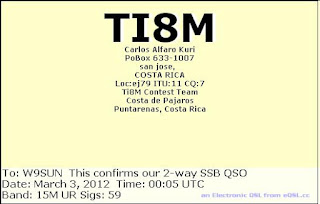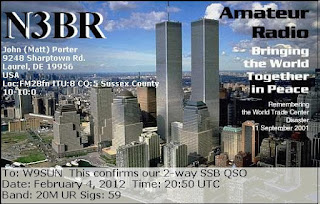Welcome to the W9SUN Amateur Radio Blog and Information Site. Some of my interests include shortwave listening, HF radio, Amateur Radio, and of course DXing. You'll find information about me and this site including some of my latest contacts, QSL cards, and general ham radio information. Now with 30 years as a SWL Shortwave Listener and 20 years with a FCC license in amateur radio along with other professional skills and certifications
Local Weather
Wednesday, June 13, 2012
Welcome to W9SUN Amateur Radio
Hello and welcome to my amateur radio page. Amateur radio is a hobby and passion that I have been involved with for 10 years while I've have been an avid shortwave radio listener and DXer for nearly twenty years having started in 1991. In 2000, I received my first amateur radio license from the Federal Communications Commission which is the regulatory body in the United States that issues amateur licenses. My first amateur license was technican class which I received in February 2000. Those privileges allows an amateur radio operator usage of the spectrum above 30 MHZ at the time. Those frequencies included the 50-54 Mhz band, 144-148 Mhz band, 220 Mhz band, 440 Mhz band, and other operating spectrum.
In 2007, I upgraded my license to General class and hope to eventually progress to Extra class in 2010. Actually, I think I could have progressed much faster if I spent the time doing as needed studying for the upgrades.
The General Class license allows the amateur radio operator more operating privileges in the General Class spectrum. Those frequencies include:
160 Meters
General, Advanced, Amateur Extra licensees:
1.800-2.000 MHz: CW, Phone, Image, RTTY/Data
80 Meters
Novice and Technician classes:
3.525-3.600 MHz: CW Only
General class:
3.525-3.600 MHz: CW, RTTY/Data
3.800-4.000 MHz: CW, Phone, Image
Advanced class:
3.525-3.600 MHz: CW, RTTY/Data
3.700-4.000 MHz: CW, Phone, Image
Amateur Extra class:
3.500-3.600 MHz: CW, RTTY/Data
3.600-4.000 MHz: CW, Phone, Image
40 Meters
Novice and Technician classes:
7.025-7.125 MHz: CW Only
General class:
7.025-7.125 MHz: CW, RTTY/Data
7.175-7.300 MHz: CW, Phone, Image
Advanced class:
7.025-7.125 MHz: CW, RTTY/Data
7.125-7.300 MHz: CW, Phone, Image
Amateur Extra class:
7.000-7.125 MHz: CW, RTTY/Data
7.125-7.300 MHz: CW, Phone, Image
30 Meters
Maximum power, 200 watts PEP. Amateurs must avoid interference to the fixed service outside the US.
General, Advanced, Amateur Extra classes:
10.100-10.150 MHz: CW, RTTY/Data
20 Meters
General class:
14.025-14.150 MHz: CW, RTTY/Data
14.225-14.350 MHz: CW, Phone, Image
Advanced class:
14.025-14.150 MHz: CW, RTTY/Data
14.175-14.350 MHz: CW, Phone, Image
Amateur Extra class:
14.000-14.150 MHz: CW, RTTY/Data
14.150-14.350 MHz: CW, Phone, Image
17 Meters
General, Advanced, Amateur Extra classes:
18.068-18.110 MHz: CW, RTTY/Data
18.110-18.168 MHz: CW, Phone, Image
15 Meters
Novice and Technician classes:
21.025-21.200 MHz: CW Only
General class:
21.025-21.200 MHz: CW, RTTY/Data
21.275-21.450 MHz: CW, Phone, Image
Advanced class:
21.025-21.200 MHz: CW, RTTY/Data
21.225-21.450 MHz: CW, Phone, Image
Amateur Extra class:
21.000-21.200 MHz: CW, RTTY/Data
21.200-21.450 MHz: CW, Phone, Image
12 Meters
General, Advanced, Amateur Extra classes:
24.890-24.930 MHz: CW, RTTY/Data
24.930-24.990 MHz: CW, Phone, Image
10 Meters
Novice and Technician classes:
28.000-28.300 MHz: CW, RTTY/Data--Maximum power 200 watts PEP
General, Advanced, Amateur Extra classes:
28.000-28.300 MHz: CW, RTTY/Data
28.300-29.700 MHz: CW, Phone, Image
6 Meters
All Amateurs except Novices:
50.0-50.1 MHz: CW Only
50.1-54.0 MHz: CW, Phone, Image, MCW, RTTY/Data
2 Meters
All Amateurs except Novices:
144.0-144.1 MHz: CW Only
144.1-148.0 MHz: CW, Phone, Image, MCW, RTTY/Data
1.25 Meters
Novice (Novices are limited to 25 watts PEP output), Technician, General, Advanced, Amateur
Extra classes:
222.00-225.00 MHz: CW, Phone, Image, MCW, RTTY/Data
70 Centimeters
All Amateurs except Novices:
420.0-450.0 MHz: CW, Phone, Image, MCW, RTTY/Data
33 Centimeters
All Amateurs except Novices:
902.0-928.0 MHz: CW, Phone, Image, MCW, RTTY/Data
23 Centimeters
Novice class:
1270-1295 MHz: CW, phone, Image, MCW, RTTY/Data (maximum power, 5 watts PEP)
All Amateurs except Novices:
1240-1300 MHz: CW, Phone, Image, MCW, RTTY/Data
Audio Streamed by the BroadWave Streaming Audio Server by NCH Software.
In 2007, I upgraded my license to General class and hope to eventually progress to Extra class in 2010. Actually, I think I could have progressed much faster if I spent the time doing as needed studying for the upgrades.
The General Class license allows the amateur radio operator more operating privileges in the General Class spectrum. Those frequencies include:
160 Meters
General, Advanced, Amateur Extra licensees:
1.800-2.000 MHz: CW, Phone, Image, RTTY/Data
80 Meters
Novice and Technician classes:
3.525-3.600 MHz: CW Only
General class:
3.525-3.600 MHz: CW, RTTY/Data
3.800-4.000 MHz: CW, Phone, Image
Advanced class:
3.525-3.600 MHz: CW, RTTY/Data
3.700-4.000 MHz: CW, Phone, Image
Amateur Extra class:
3.500-3.600 MHz: CW, RTTY/Data
3.600-4.000 MHz: CW, Phone, Image
40 Meters
Novice and Technician classes:
7.025-7.125 MHz: CW Only
General class:
7.025-7.125 MHz: CW, RTTY/Data
7.175-7.300 MHz: CW, Phone, Image
Advanced class:
7.025-7.125 MHz: CW, RTTY/Data
7.125-7.300 MHz: CW, Phone, Image
Amateur Extra class:
7.000-7.125 MHz: CW, RTTY/Data
7.125-7.300 MHz: CW, Phone, Image
30 Meters
Maximum power, 200 watts PEP. Amateurs must avoid interference to the fixed service outside the US.
General, Advanced, Amateur Extra classes:
10.100-10.150 MHz: CW, RTTY/Data
20 Meters
General class:
14.025-14.150 MHz: CW, RTTY/Data
14.225-14.350 MHz: CW, Phone, Image
Advanced class:
14.025-14.150 MHz: CW, RTTY/Data
14.175-14.350 MHz: CW, Phone, Image
Amateur Extra class:
14.000-14.150 MHz: CW, RTTY/Data
14.150-14.350 MHz: CW, Phone, Image
17 Meters
General, Advanced, Amateur Extra classes:
18.068-18.110 MHz: CW, RTTY/Data
18.110-18.168 MHz: CW, Phone, Image
15 Meters
Novice and Technician classes:
21.025-21.200 MHz: CW Only
General class:
21.025-21.200 MHz: CW, RTTY/Data
21.275-21.450 MHz: CW, Phone, Image
Advanced class:
21.025-21.200 MHz: CW, RTTY/Data
21.225-21.450 MHz: CW, Phone, Image
Amateur Extra class:
21.000-21.200 MHz: CW, RTTY/Data
21.200-21.450 MHz: CW, Phone, Image
12 Meters
General, Advanced, Amateur Extra classes:
24.890-24.930 MHz: CW, RTTY/Data
24.930-24.990 MHz: CW, Phone, Image
10 Meters
Novice and Technician classes:
28.000-28.300 MHz: CW, RTTY/Data--Maximum power 200 watts PEP
General, Advanced, Amateur Extra classes:
28.000-28.300 MHz: CW, RTTY/Data
28.300-29.700 MHz: CW, Phone, Image
6 Meters
All Amateurs except Novices:
50.0-50.1 MHz: CW Only
50.1-54.0 MHz: CW, Phone, Image, MCW, RTTY/Data
2 Meters
All Amateurs except Novices:
144.0-144.1 MHz: CW Only
144.1-148.0 MHz: CW, Phone, Image, MCW, RTTY/Data
1.25 Meters
Novice (Novices are limited to 25 watts PEP output), Technician, General, Advanced, Amateur
Extra classes:
222.00-225.00 MHz: CW, Phone, Image, MCW, RTTY/Data
70 Centimeters
All Amateurs except Novices:
420.0-450.0 MHz: CW, Phone, Image, MCW, RTTY/Data
33 Centimeters
All Amateurs except Novices:
902.0-928.0 MHz: CW, Phone, Image, MCW, RTTY/Data
23 Centimeters
Novice class:
1270-1295 MHz: CW, phone, Image, MCW, RTTY/Data (maximum power, 5 watts PEP)
All Amateurs except Novices:
1240-1300 MHz: CW, Phone, Image, MCW, RTTY/Data
Audio Streamed by the BroadWave Streaming Audio Server by NCH Software.
Thursday, March 22, 2012
Hoping For Good Propagation
After less than stellar results in the ARRL International DX Contest, I'm hoping for better propagation after the last few weeks of solar storms, wacky weather, and all the other radio fun issues that we deal with as Hams. Love this hobby and I don't see ever leaving it although work considerations and family considerations always take priority. Love being able to work various DX and looking for DX Stations around the world. The last couple of weeks especially from March 4th to the 17th were less than spectacular on the HF bands with S9 noise levels from solar activity. Usually at this QTH I'm fortunate to usually have S3 noise levels or below on 20/17/15/12/10 Meters. Here's hoping it will be a great weekend to work stations around the world with the WPX Contest. Can't wait.
Some Fresh Newer QSL Cards I've Received














I've been a little busy so I've been kind of delinquent on putting together some new QSL Cards on this site. I also have quite a few paper ones that have been through the postal system lately too that I need to scan and add. Going to be working the WPX Contest on March 24th and March 25th, 2012 so look for me on the air mostly on 40, 20, 15, and 10 since I don't have an adequate 75 meter antenna. Good luck with the contest and 73s.
W9SUN
Tuesday, January 31, 2012
Monday, January 30, 2012
DX Code of Conduct

DX Code Of Conduct
(various languages inside)
I will listen, and listen, and then listen again before calling.
I will only call if I can copy the DX station properly.
I will not trust the DX cluster and will be sure of the DX station's call sign before calling.
I will not interfere with the DX station nor anyone calling and will never tune up on the DX frequency or in the QSX slot.
I will wait for the DX station to end a contact before I call.
I will always send my full call sign.
I will call and then listen for a reasonable interval. I will not call continuously.
I will not transmit when the DX operator calls another call sign, not mine.
I will not transmit when the DX operator queries a call sign not like mine.
I will not transmit when the DX station requests geographic areas other than mine.
When the DX operator calls me, I will not repeat my call sign unless I think he has copied it incorrectly.
I will be thankful if and when I do make a contact.
I will respect my fellow hams and conduct myself so as to earn their respect.
Subscribe to:
Comments (Atom)